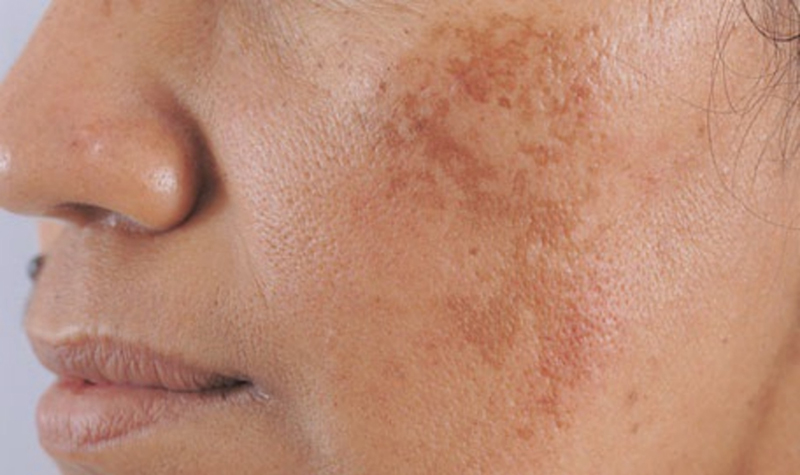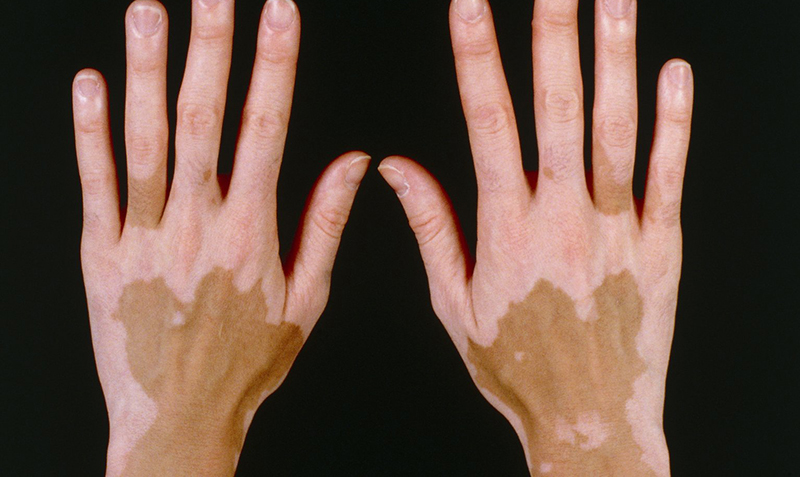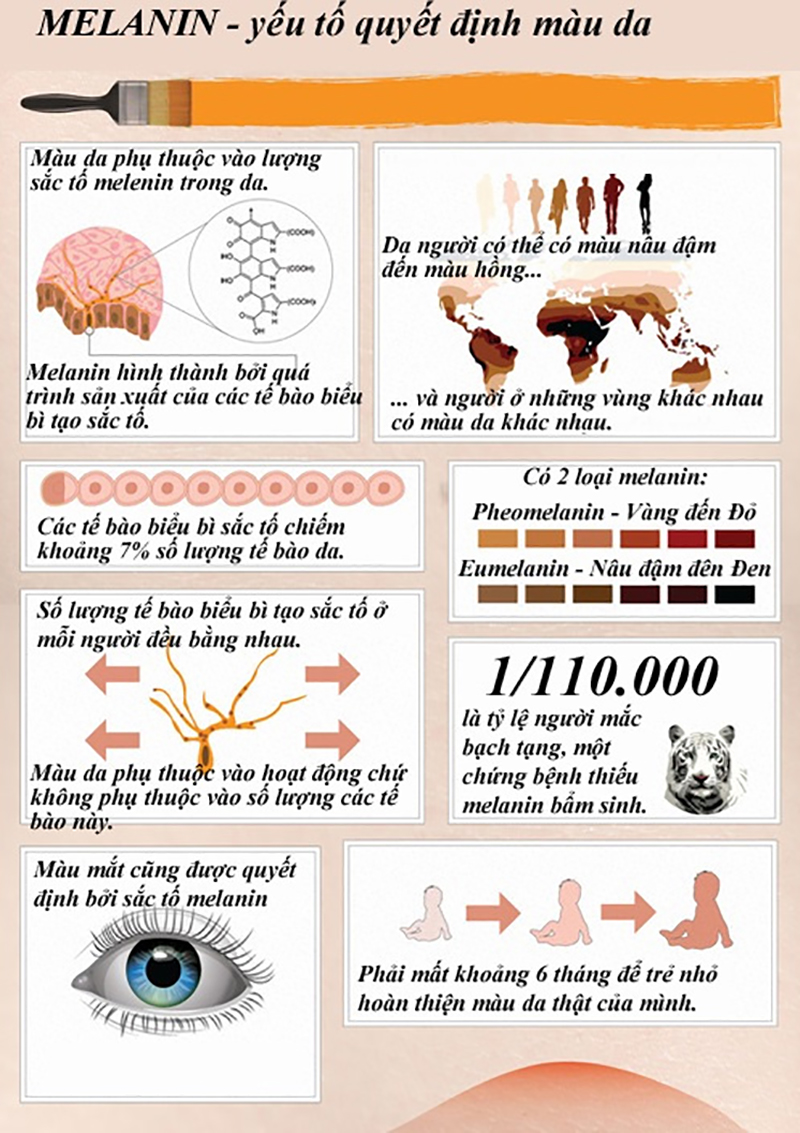You are viewing the article What is melanin pigment? Learn the formation of dark spots, melasma caused by melanin at Tnhelearning.edu.vn you can quickly access the necessary information in the table of contents of the article below.
What is Melanin?
Melanin is the pigment that determines the color of each person’s skin , produced from skin cells called melanocytes (melanocytes), located in the basal layer of the epidermis. Melanocytes contain the enzyme Tyrosinase.
Melanin is formed by the action of the enzyme Tyrosinase and also by environmental agents mainly due to ultraviolet rays in sunlight. In addition, the production of melanin is also influenced by hormones and nerves.
Melanin pigment exists in two main forms: dark brown to black eumelanin and red brown pheomelanin. These molecules exist in different proportions creating many different types of skin in the human body.
Eumelanin is most abundant in people with dark skin. Eumelanin gives brown and black pigment to skin, hair and eyes. Therefore, as people age, there are signs of gray hair because the melanin content is now produced less and less. The hair will gradually lose its original black color.
Where is Melanin?
Melanin is found in hair, skin, the pigment in the black of the eyes,…
When young, the human body produces enough melanin to give color to hair, skin, … but as we grow older, the amount of melanin produced gradually decreases, so there will be dull skin, hair color becomes gray than.
Diseases caused by Melanin
Albino
Albinism is an inherited hypopigmentation disease , associated with an activity disorder that causes a decrease in the production or a complete loss of the production of melanin pigment in the body. Reduces even pigmentation in skin, hair and retina.
The general manifestations of people with albinism are fair skin, light white hair and may have vision problems, especially eye color can also change with age and range in color from light blue to brown. There are different classifications from severe to mild, but there is currently no cure.
 People with albinism
People with albinism
Melasma
The phenomenon of dark patches, spots, black or gray-brown appearing on the face is a manifestation of melasma. There are many causes of skin pigmentation that are due to: Hormone disorders in the body, genetics, the impact of sunlight, birth control pills, or improper skin care regimen, .. .Melasma treatment methods are using sunscreen, laser treatment, chemical peels but can only fade but not cure completely.
 People with melasma have brown patches on their face
People with melasma have brown patches on their face
Vitiligo
Vitiligo occurs when there is loss of melanocytes, the appearance of smooth white patches of skin. To treat this type of disease can apply methods: Using dyes, UV radiation therapy, light-sensitive drugs, corticosteroid creams and surgery. This is a benign, non-communicable disease and currently there is no cure for it
 Loss of pigmentation after skin damage
Loss of pigmentation after skin damage
Loss of pigmentation after skin damage
For skin damaged by burns, blisters or infections, the body can no longer produce the amount of melanin in the damaged area, leading to loss of skin pigmentation, making the skin uneven color. Although it does not affect the body, but it is unsightly, you can cover this area with makeup if you want.
Parkinson disease
For people with Parkinson’s disease – one of the neurological diseases, the amount of neuromelanin in the brain of the patient is reduced because brain cells in the substantia nigra area die. Symptoms of the disease are the inability to control muscle movement, leading to difficulty walking, slow leg movements, and stiff limbs. Normally, as we age, the amount of neuromelanin in the brain increases.
 People with hearing loss
People with hearing loss
Hearing loss
Melanin plays an important role affecting hearing. Some studies suggest that people with too little melanin may experience hearing loss or deafness.
Structure of Melanin
Skin color, hair color and eye color in humans are made up of the pigments Melanin (black), Carotene (yellow), Oxyhemoglobin (red) and reduced Hemoglobin (blue).
Melanin is irregular granules, arising from the basal cells of the epidermis (epidermis) in the skin structure.

They are responsible for the color of the skin, hair and eyes, and this responsibility depends on the blood flow of each body. Although there are many other factors that determine your skin color, melanin is the main cause.
Melanin is like a “double-edged sword”. They both protect the natural skin, and are the culprits that cause the skin to become dark.
The main role of Melanin
The role of Melanin is also extremely important for the skin. Melanin helps to resist the effects of heat from the outside: fire and sun. Melanin helps balance body temperature and helps fight bacteria. The presence of Melanin helps the body to resist ultraviolet radiation . From there, they help to anti-oxidize the skin. However, too much melanin can cause melasma.
More importantly, humans cannot determine the amount of Melanin. There are three main factors that directly affect Melanin levels: genetics, vitamin D, and UV exposure. Science proves that if the body lacks Melanin for a long time, it can cause death . It is caused by a lack of vitamin D in the body.
Melanin depends on the amount of melanin pigment in the skin due to the production processes of melanocytes (melanocytes). This results in human skin having different dark and light colors, and people in different regions will also have different skin colors.
Pigmented epidermal cells make up about 7% of skin cells. There are 2 main types of melanin:
- Pheomelanin (Yellow to red)
- Eumelanin (Dark brown to black)
The number of pigment-producing epidermal cells in humans is equal. Skin color depends on activity, not on the number of these cells. In addition, the rate of people infected with albinism – a disease that occurs in people with congenital lack of melanin is 1 in 110,000.
Eye color is also determined by melanin and babies take up to 6 months to perfect their skin color.

Melanin production mechanism
Melanin is considered the main cause of the formation of dark spots on the skin . When the amount of melanin increases excessively, a major cause of increased melanin production in the body is exposure to the sun for too long and then when the UV light is no longer exposed, the amount of melanin produced becomes excess. leading to melasma, black skin.

How to increase melanin
 How to increase melanin
How to increase melanin
To be able to increase melanin pigment for the skin, the use of nutrients found in nature is one of the simplest and easiest ways to do it. Studies suggest that the following nutrients can help your body produce more melanin.
Antioxidant supplement
Antioxidants work to prevent premature aging as well as degenerative diseases of the body, in addition, they also have the ability to increase melanin production . Applying a diet rich in fruits and vegetables, nuts, whole grains and some meats (poultry and fish, …) is one of the ways to supplement antioxidants. oxidize.
Vitamin A Supplement
Vitamin A is an important vitamin for skin health, as it contains beta carotene and carotenoids (which give red, yellow and orange colors) that play a role in melanin production and UV protection. You can get vitamin A by eating a variety of vegetables, such as carrots, sweet potatoes, spinach and peas, fish and meat.
However, it is important to use vitamin A sensibly because vitamin A is a fat-soluble vitamin, so it can accumulate in your body. The US National Institutes of Health recommends:
Vitamin E Supplement
Supplementing with vitamin E is one of the effective ways to increase melanin pigmentation because vitamin E itself is also an antioxidant and can increase melanin levels. In addition, some studies also show that the use of vitamin E will help protect the skin from sun damage.
You can get vitamin E in two ways: Take pills that contain vitamin E or eat more vitamin E-rich foods like vegetables, whole grains, nuts and seeds.
Herbs and plants
Green tea and turmeric, which are rich in flavonoids and polyphenols, can increase pigmentation and may help protect skin from UV damage. Although there are no studies that prove herbs increase melanin production, the fact that using these herbs really works for your skin.
So I have introduced you to the basic information about what melanin is. Hopefully with this information you will understand more about melanin and know how to take better care of your skin.
You will be interested in:
>>> What is collagen? What is the effect of collagen on the skin and body?
>>> What are free radicals? And how do they affect your skin and health?
>>> What are parabens? Harmful effects of cosmetics containing parabens
Good experience Tnhelearning.edu.vn
Thank you for reading this post What is melanin pigment? Learn the formation of dark spots, melasma caused by melanin at Tnhelearning.edu.vn You can comment, see more related articles below and hope to help you with interesting information.
Related Search:

